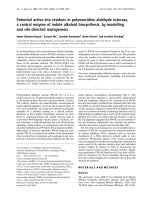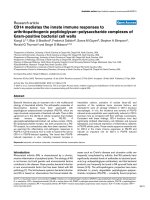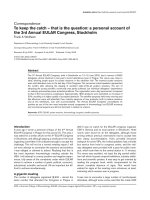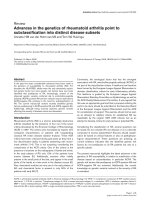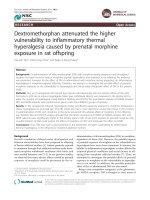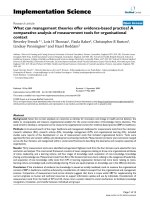Báo cáo y học: "To keep the catch – that is the question: a personal account of the 3rd Annual EULAR Congress, Stockholm" potx
Bạn đang xem bản rút gọn của tài liệu. Xem và tải ngay bản đầy đủ của tài liệu tại đây (33.39 KB, 3 trang )
ACR = American College of Rheumatology; EULAR = European League Against Rheumatism; VIP = very important person.
Available online />Introduction
A year ago I wrote a personal critique of the 2
nd
Annual
EULAR Congress in Prague for this journal [1]. This year, I
was asked for a similar article on the 3
rd
EULAR Congress
in Stockholm, and although playing a small part in the local
organizing committee I felt unbiased enough to accept the
challenge. This will not be a normal meeting report; I will
not even attempt to summarize the sessions and activities
I was obliged or allowed to attend. Realizing that this is
the most important rheumatologic meeting outside the
USA, I will attempt to convey positive and negative experi-
ences, fully aware of the constraints under which EULAR
strives to achieve a number of goals, political, economic,
educational, scientific and social. All are important but dif-
ficult to achieve simultaneously.
A gigantic meeting
The number of delegates registered (8,300 — almost the
same number that attended the Congress in Prague in
2001) was no match for the EULAR congress organizer
CMI in Geneva and its local partner in Stockholm. Hotel
rooms were found for all the delegates, although those
arriving without previous reservations had to accept less
than classy accommodation. Volvo provided limousine
transport for some VIPs, the invited speakers had a shuttle
bus service from hotel to congress center, and the ordi-
nary delegates were provided with a pass for public trans-
port, which took them to the central station in 11 minutes.
The venue was excellent, not least the big central exhibi-
tion hall which housed nonprofit exhibitors, industry exhibi-
tions and scientific posters. It was easy to get oriented by
reading the program book, which compensated for the
almost complete absence of signs. One would have
wished for signs at the meeting room entrances, at least,
indicating which session was in progress.
It was nice to encounter a large number of non-European
attendees, although some voices said that this made ACR
The 3
rd
Annual EULAR Congress, held in Stockholm on 12–15 June 2002, had a turnout of 8300
delegates, almost identical to last year’s record attendance level in Prague. The venue was close to
ideal, allowing ample space for poster sessions in the exhibition hall. The manned poster sessions
were well attended, even on the last day of the Congress. The numerous invited speakers represented
the world’s elite, allowing the staging of excellent state-of-the-art podium sessions. The aim of
attracting the young scientific community was partly achieved, but individual delegates’ dependence
on industry sponsorship poses potential problems. The organization was a big improvement compared
to that of the two previous congresses. Approximately 1800 abstracts were submitted, an increase of
50%, resulting in a higher quality of accepted abstracts. The satellite symposia held every morning and
late afternoon were well attended; thus, industry exposure of new products, both in podium sessions
and at the exhibitions, was well accommodated. The Annual EULAR Congress consolidates its
position as one of the two most important annual congresses of rheumatology, but EULAR economy
and commercial aspects are still too dominant in relation to science.
Keywords: ACR, EULAR, poster sessions, rheumatology congress, satellite symposia
Correspondence
To keep the catch – that is the question: a personal account of
the 3rd Annual EULAR Congress, Stockholm
Frank A Wollheim
Department of Rheumatology, Lund University Hospital, Lund, Sweden
Corresponding author: Frank A Wollheim (e-mail: )
Received: 8 July 2002 Accepted: 9 July 2002 Published: 18 July 2002
Arthritis Res 2002, 4:E007
© 2002 BioMed Central Ltd (
Print ISSN 1465-9905; Online ISSN
1465-9913)
Abstract
Arthritis Research Vol 4 No 5 Wollheim
observers nervous. My belief is that attendance of most
non-European delegates not invited by the Congress orga-
nizers was paid for by industry, either directly (as industry
employees) or by individual invitations of sponsorship.
The Congress fee was again impressively high, but
included a one-year subscription to the Annals of
Rheumatic Diseases, the official EULAR journal. This now
has an impact factor of over 3 and is next only to the ACR
journal Arthritis and Rheumatism in its field. The submis-
sion rate to the Annals is increasing substantially these
days. Editors of other journals may be envious, but
perhaps this is the start towards one European competitor
for the ACR journal. The cost for registration was even
higher for Swedish delegates, who were forced to pay
VAT (value-added tax). This resulted in a major effort to
subsidize juniors’ participation by providing bursaries to
those with the best abstracts, and also in enrollment of a
large number of volunteer workers, working 50% of the
congress time. These arrangements resulted in a nice
turnout from Sweden, but reduced the Swedish Society’s
net income from the Congress.
The opening ceremony
The opening ceremony was attended by 4000 delegates,
and featured modernized folk tunes and modern Swedish
music of various kinds, mostly too loud for my taste. I
missed a Queen named Silvia, who has a keen interest in
handicapped children, and whose presence would have
been all the more fitting, considering that the EULAR Con-
gress this year also included the 9
th
European Paediatric
Rheumatology Congress. Instead we were briefly
addressed by the vice chancellor of Karolinska Institutet,
Hans Wigzell, who invited us to find the cause of rheuma-
toid arthritis and its cure. When this had been achieved he
would be pleased to invite another Nobel laureate from
amongst us. He indicated that the task should not be
impossible, now that vaccination had advanced to the point
where even cucumbers could be vaccinated! At the subse-
quent reception both wine and food were plentiful, and I
even spotted traces of cucumbers, vaccinated or not.
The scientific podium presentations
The invited presenters numbered over 300 and there was
a global spread of speakers, rather than a European
spread. I think this is exactly the right policy, although
probably to some extent controversial. The chairman of the
scientific committee, Steffen Gay, had again brought
together an impressive selection of frontline investigators.
It was also nice to spot a couple of younger presenters,
mostly selected from those who submitted abstracts.
The “Scientific forum for young rheumatologists” was
given two sessions rather than one, and included not only
young speakers who had participated in the ACR/EULAR
exchange program but also some from Korea and China.
The significance of this session was underlined by the
choice of chairmen, Joachim Kalden and Peter Lipsky.
Unfortunately, this interesting program coincided with a
session on genetics, cell signaling and cytokines with
invited speakers Tim Vyse, Jerry Saklatvala and Ian
McInnes, and with a session on molecular aspects of
tissue repair, which I co-chaired. Every conscientious dele-
gate must have experienced daily frustrations with regard
to which session to attend, and I heard some friends
saying that a dominating feeling after the Congress was
regret at all the sessions one had been unable to take in.
Is there a way out from this dilemma? One strategy I
would favor would involve fewer parallel sessions and
would streamline the program into one basic/experimental,
one clinical research, one clinical problem discussion and
one state-of-the-art/update line of sessions. Having fewer
invited speakers would certainly incur some disappoint-
ment among the rank and file congress speakers, and their
absence would attenuate the quality of the discussions.
Perhaps the Organizing Committee could invite discus-
sion-panel participants who would not present a lecture
themselves. This was a role often (not always) played by
competent chairmen at the EULAR congress, and it is
used in several smaller scientific workshops.
Lively poster sessions
The three poster sessions, featuring some 350 posters
each, were a very positive experience as I see it. The
average quality of the posters was distinctly better than
last year’s, and the selecting committees had more sub-
missions from which to choose. Importantly, the midday,
manned, poster sessions were well attended. Even the
morning session on the last half day of the Congress was
far from empty. I encountered both established and young
presenters. Some were from countries like Japan, and,
according to the presenters, were supported by the
medical institution in which they worked. This is indeed
encouraging and will hopefully continue.
Satellite symposia and industry support
Coming back to the problem of conflicting concomitant ses-
sions, one was impressed by the fact that three hours on
each of the three full Congress days were reserved for
satellite symposia. They did not overlap with the Congress
program, but their existence reduced the time available for
the EULAR program itself. An obvious way to improve this
situation would be to move all satellite meetings to one or
two days before or after the scientific meeting. This would
allow accommodation of three more hours of proper Con-
gress program every day, but would not be popular with the
industry. Industry invests substantially in the EULAR con-
gress, and the shareholders want sales promoting returns.
Eric Bywaters and others addressed these problems in the
past and criticized commercialism in the EULAR Con-
gresses, as he recently told me, without much success.
We fully appreciate the legitimate need of industry to
expose scientific progress. But I believe there should be a
mutual interest in separating marketing/advertising, be it
open or disguised, from scientific reporting. I am naive
enough to believe that the goodwill generated by unre-
stricted sponsorship for scientific exchange (product unre-
lated) cannot be overestimated, and I have personal
experience to support this belief. The legitimate and mutual
interest in hearing about and discussing novel therapeutic
developments should be accommodated in the Congress
program itself. The results should be openly presented and
discussed, just like all other material presented at the Con-
gress. And the satellites could be arranged under the
umbrella of the Congress but on separate days.
The risk with organizing the Congress this way is that fewer
individuals will attend the Congress, but perhaps it will be
those who were seen in the scientific sessions in Stock-
holm anyway, so the real loss may be insignificant. Let it be
no secret: a substantial proportion of the 8,300 delegates
enjoyed archipelago cruises and other outside activities,
rather than attending the congress sessions. Unfortunately,
some of these escape activities were organized by indus-
try. I wonder how many of the 8,300 registered delegates
were present during peak hours of the congress.
A more sensitive risk is that the Congress would lose paying
delegates and therefore make less profit. I leave it to the
wise men in the EULAR leadership to contemplate what
might be done. Right now they can negotiate from a posi-
tion of strength, based not only on the turnout and success
in Stockholm, but also on the large number of interesting
new products on the market or in development. Industry
needs EULAR at least as much as EULAR needs industry.
The pre-Congress organization
Abstracts and conference program
The electronic submission of abstracts seemed to work
better than last year, although I heard of some problems
from Australian colleagues. The abstract selection system
allowed for four possible outcomes: podium presentation,
poster presentation, rejection or abstract-book printing
only. The last category was said to be necessary to accom-
modate people who otherwise would not be allowed to
travel to the congress. This category is probably very small
after the recent political developments in the world, elimi-
nating travel restrictions other than economic. I believe the
abstract-book-only category is dispensable for the next
EULAR Congress. This year the program and abstracts
were indeed available on the web site before the meeting,
although for reasons I don’t understand could only be
accessed using Internet Explorer and not Netscape.
Accommodation
The hotel reservations were probably handled as well as
they could be, although I understand that the availability of
attractive hotel options for those who were not invited by
the Congress organizers or sponsored by large compa-
nies was negligible.
The Annual EULAR Congress and other
European rheumatology meetings
There does not seem to be any doubt that attendance at
the Annual EULAR Congress will be essential for key
players from academia, clinical practice and industry in
years to come. How will this influence the more local
rheumatology meetings in Europe? Originally it was
planned to incorporate the 2002 Scandinavian meeting in
the EULAR Congress, but the Swedish Society did not
want to do this. Another Scandinavian country, Norway,
promptly volunteered to arrange the Scandinavian con-
gress for 2002. Although it will be held only two months
after the Stockholm meeting, and although the number of
delegates will be lower than it was two years ago in
Finland, the meeting will be of a reasonable size. The
British and continental meetings continue to attract large
crowds. My prediction, therefore, is that we will not see
any large reduction in national meetings because of
EULAR’s annual congresses.
Conclusion
The Congress in Stockholm marked a distinct step
forward with regard to overall scientific quality and, in par-
ticular, many more young rheumatologists and trainees
presented their work. The poster sessions were, for me,
enjoyable for the first time. Some major problems remain
to be addressed, however. The very high Congress fee
makes participation dependent on industrial sponsorship
of registrants unless they are the lucky recipients of grant
money or have been invited by the Congress. The vulnera-
bility of this system is obvious. The chairman of the scien-
tific committee this year, Steffen Gay, has laid a splendid
foundation for his successor, Maxime Dougados, but also
leaves some challenges: to ensure the young and active
investigator’s presence; to allow the poster sessions to
play a leading role in Lisbon 2003 and Berlin 2004; to
streamline the program and reduce the number of parallel
sessions; and, most difficult, to incorporate industrial
developments in the Congress program and move the
sponsored satellite symposia to before or after the con-
gress. We all wish him good luck with the important task
of keeping the catch, that is to say, the young generation,
involved in the future EULAR congresses.
Reference
1. Wollheim FA: Morgenröthe or business as usual: a personal
account of the 2nd Annual EULAR Congress, Prague. Arthritis
Res 2001, 3:E006.
Correspondence
Frank A Wollheim MD, PhD, FRCP, Department of Rheumatology,
Lund University Hospital, S-221 85 Lund, Sweden. Tel: +46 46
172280; fax: +46 46 128468; e-mail:
Available online />

